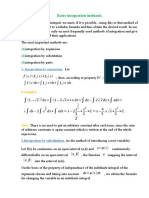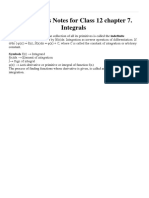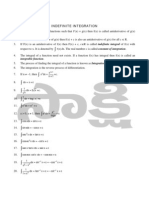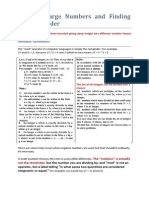Integrals
Uploaded by
p8105274Integrals
Uploaded by
p8105274Chapter – 07
Integrals
Memory Tips
Integration is defined as the inverse process of differentiation.
The process of finding a function from its derivative is called integration.
d
If dx {g(x)} = f(x), then g(x) is called an integral or a primitive or anti-derivative of f(x) and is
denoted by ∫ f(x) dx.
In general, ∫ f(x) dx = g(x) + c
Algebra of Indefinite Integrals:
i. ∫ 𝑘 𝑑𝑥 = 𝑘 ∫ 𝑑𝑥 = 𝑘𝑥 + 𝑐
ii. ∫ 𝑘 𝑓(𝑥)𝑑𝑥 = 𝑘 ∫ 𝑓(𝑥)𝑑𝑥
iii. ∫[𝑓(𝑥) ± 𝑔(𝑥)] 𝑑𝑥 = ∫ 𝑓(𝑥)𝑑𝑥 ± ∫ 𝑔(𝑥)𝑑𝑥
iv. ∫ 0 𝑑𝑥 = 𝑐
v. ∫ 𝑑𝑥 = 𝑥 + 𝑐
Some Standard Formulae:
𝑥 𝑛+1
1. ∫ 𝑥 𝑛 𝑑𝑥 =
1
𝑛+1
+ 𝑐, 𝑛 ≠ −1 JK
2. ∫ 𝑥 𝑑𝑥 = log|𝑥| + 𝑐
RA
3. ∫ sin 𝑥 𝑑𝑥 = −𝑐𝑜𝑠𝑥 + 𝑐
4. ∫ 𝑐𝑜𝑠𝑥 𝑑𝑥 = 𝑠𝑖𝑛𝑥 + 𝑐
EN
5. ∫ 𝑠𝑒𝑐 2 𝑥 𝑑𝑥 = 𝑡𝑎𝑛𝑥 + 𝑐
6. ∫ 𝑐𝑜𝑠𝑒𝑐 2 𝑥 𝑑𝑥 = − cot 𝑥 + 𝑐
H
EP
7. ∫ 𝑠𝑒𝑐𝑥 . 𝑡𝑎𝑛𝑥 𝑑𝑥 = 𝑠𝑒𝑐𝑥 + 𝑐
8. ∫ 𝑐𝑜𝑠𝑒𝑐𝑥 . 𝑐𝑜𝑡𝑥 𝑑𝑥 = −𝑐𝑜𝑠𝑒𝑐𝑥 + 𝑐
ST
𝑎𝑥
9. ∫ 𝑎 𝑥 𝑑𝑥 = + 𝑐 , 𝑎 > 0, 𝑎 ≠ 1
log 𝑎
10. ∫ 𝑒 𝑥 𝑑𝑥 = 𝑒 + 𝑐 𝑥
𝑎𝑚𝑥
11. ∫ 𝑎𝑚𝑥 𝑑𝑥 = +𝑐
𝑚 log 𝑎
1
12. ∫ 𝑒 𝑚𝑥 𝑑𝑥 = 𝑚 𝑒 𝑚𝑥 + 𝑐
1
13. ∫ √1−𝑥2 𝑑𝑥 = sin−1 𝑥 + 𝑐 = − cos −1 𝑥 + 𝑘
1
14. ∫ 1+𝑥 2 𝑑𝑥 = tan−1 𝑥 + 𝑐 = − cot −1 𝑥 + 𝑘
1
15. ∫ |𝑥|√𝑥2 𝑑𝑥 = sec −1 𝑥 + 𝑐 = − cosec −1 𝑥 + 𝑘
−1
Methods of Integration:
We have the following methods of integration.
✓ Integration by substitution
✓ Integration by parts
✓ Integration of rational algebraic functions by using partial fractions.
Integration By Substitution:
If 𝑔(𝑥) is a continuously differentiable function, then to evaluate integrals of the form
1|Page
PREPARED BY, K. STEPHEN RAJ -9943361320
∫ 𝑓(𝑔(𝑥))𝑔′ (𝑥)𝑑𝑥
We substitute 𝑔(𝑥) = 𝑡 and 𝑔′ (𝑥)𝑑𝑥 = 𝑑𝑡
These substitutions reduce the above integral to ∫ 𝑓(𝑡)𝑑𝑡
After evaluating this integral we substitute back the value of 𝑡.
Some Formulae:
1 (𝑎𝑥+𝑏)𝑛+1
1. ∫(𝑎𝑥 + 𝑏)𝑛 𝑑𝑥 = 𝑎 + 𝑐, 𝑛 ≠ −1.
𝑛+1
1
2. ∫ sin(𝑎𝑥 + 𝑏) 𝑑𝑥 = − 𝑎 cos(𝑎𝑥 + 𝑏) + 𝑐
1
3. ∫ cos(𝑎𝑥 + 𝑏)𝑑𝑥 = 𝑎 sin(𝑎𝑥 + 𝑏) + 𝑐
1
4. ∫ 𝑠𝑒𝑐 2 (𝑎𝑥 + 𝑏)𝑑𝑥 = 𝑎 tan(𝑎𝑥 + 𝑏) + 𝑐
1
5. ∫ 𝑐𝑜𝑠𝑒𝑐 2 (𝑎𝑥 + 𝑏)𝑑𝑥 = − 𝑎 cot(𝑎𝑥 + 𝑏) + 𝑐
1
6. ∫ sec(𝑎𝑥 + 𝑏) tan(𝑎𝑥 + 𝑏)𝑑𝑥 = 𝑎 sec(𝑎𝑥 + 𝑏) + 𝑐
1
7. ∫ 𝑐𝑜𝑠𝑒𝑐 (𝑎𝑥 + 𝑏) cot(𝑎𝑥 + 𝑏)𝑑𝑥 = − 𝑎 𝑐𝑜𝑠𝑒𝑐(𝑎𝑥 + 𝑏) + 𝑐
1
8. ∫ tan(𝑎𝑥 + 𝑏)𝑑𝑥 = 𝑎 log|sec(𝑎𝑥 + 𝑏)| + 𝑐
1
9. ∫ cot(𝑎𝑥 + 𝑏)𝑑𝑥 = 𝑎 log|sin(𝑎𝑥 + 𝑏)| + 𝑐
1
10. ∫ sec(𝑎𝑥 + 𝑏)𝑑𝑥 = 𝑎 log|sec(𝑎𝑥 + 𝑏) + tan(𝑎𝑥 + 𝑏)| + 𝑐
1
11. ∫ 𝑐𝑜𝑠𝑒𝑐(𝑎𝑥 + 𝑏)𝑑𝑥 = 𝑎 log|𝑐𝑜𝑠𝑒𝑐(𝑎𝑥 + 𝑏) − cot(𝑎𝑥 + 𝑏)| + 𝑐
JK
RA
1 𝑎𝑚𝑥+𝑏
12.∫ 𝑎𝑚𝑥+𝑏 𝑑𝑥 = 𝑚 +𝑐
log 𝑎
1
13. ∫ 𝑒 𝑚𝑥+𝑏 𝑑𝑥 = 𝑚 𝑒 𝑚𝑥+𝑏 + 𝑐
EN
1 1
14. ∫ 𝑎𝑥+𝑏 𝑑𝑥 = 𝑎 log|𝑎𝑥 + 𝑏| + 𝑐
H
𝑓′(𝑥)
EP
15. ∫ 𝑓(𝑥) 𝑑𝑥 = log|𝑓(𝑥)| + 𝑐
𝑓′(𝑥)
16. ∫ 𝑑𝑥 = 2√𝑓(𝑥) + 𝑐
ST
√𝑓(𝑥)
Evaluation of Integrals of the type
∫ 𝐬𝐢𝐧 𝒎𝒙 𝐜𝐨𝐬 𝒏𝒙 𝒅𝒙 , ∫ 𝐬𝐢𝐧 𝒎𝒙 𝐬𝐢𝐧 𝒏𝒙 𝒅𝒙 , 𝒐𝒓 ∫ 𝐜𝐨𝐬 𝒎𝒙 𝐜𝐨𝐬 𝒏𝒙 𝒅𝒙
To evaluate integrals of the above form, we use the following trigonometrical identities.
2 sin 𝐴 cos 𝐵 = sin(𝐴 + 𝐵) + sin(𝐴 − 𝐵)
2 cos 𝐴 sin 𝐵 = sin(𝐴 + 𝐵) − sin(𝐴 − 𝐵)
2 𝑐𝑜𝑠𝐴 cos 𝐵 = cos(𝐴 + 𝐵) + cos(𝐴 − 𝐵)
2 sin 𝐴 𝑠𝑖𝑛𝐵 = cos(𝐴 − 𝐵) − cos(𝐴 + 𝐵), where 𝐴 > 𝐵
Evaluation of Integrals of the form ∫ 𝒔𝒊𝒏𝒎 𝒙 𝒄𝒐𝒔𝒏 𝒙 𝒅𝒙, the following substitutions are useful.
(𝑖) If the exponent of 𝑠𝑖𝑛𝑥 is odd, put 𝑐𝑜𝑠𝑥 = 𝑡.
(𝑖𝑖) If the exponent of 𝑐𝑜𝑠𝑥 is odd, put 𝑠𝑖𝑛𝑥 = 𝑡.
(𝑖𝑖𝑖) If the exponents of 𝑠𝑖𝑛𝑥 and 𝑐𝑜𝑠𝑥 both are odd, put either 𝑠𝑖𝑛𝑥 = 𝑡 or 𝑐𝑜𝑠𝑥 = 𝑡.
(𝑖𝑣) If the exponents of 𝑠𝑖𝑛𝑥 and 𝑐𝑜𝑠𝑥 both are even integers, then 𝑠𝑖𝑛𝑚 𝑥 𝑐𝑜𝑠 𝑛 𝑥 in terms of
sines and cosines of multiples of 𝑥 by using trigonometric results.
(𝑣) Let the integral is either of the forms ∫ 𝑠𝑖𝑛𝑚 𝑥 𝑑𝑥 or ∫ 𝑐𝑜𝑠 𝑚 𝑥 𝑑𝑥. Then put
1−cos 2𝑥 1−cos 2𝑥 3 𝑠𝑖𝑛𝑥 −sin 3𝑥 3 𝑐𝑜𝑠𝑥+cos 3𝑥
𝑠𝑖𝑛2 𝑥 = , 𝑐𝑜𝑠 2 𝑥 = , 𝑠𝑖𝑛3 𝑥 = , 𝑐𝑜𝑠 3 𝑥 =
2 2 4 4
2|Page
PREPARED BY, K. STEPHEN RAJ -9943361320
Integration By Trigonometric Substitution:
𝑑𝑥 𝑥
1. ∫ √𝑎2 = sin−1 + 𝑐
−𝑥 2 𝑎
𝑑𝑥 1 −1 𝑥
2. ∫ 𝑥 2 + 𝑎2 = tan 𝑎 +𝑐
𝑎
𝑑𝑥
3. ∫ √𝑥 2 = log|𝑥 + √𝑥 2 + 𝑎2 | + 𝑐
+𝑎2
𝑑𝑥
4. ∫ √𝑥 2 = 𝑙𝑜𝑔|𝑥 + √𝑥 2 − 𝑎2 | + 𝑐
− 𝑎2
𝑑𝑥 1 𝑥
5. ∫ = sec −1 𝑎 + 𝑐
𝑥 √𝑥 2 − 𝑎2 𝑎
𝑑𝑥 1 𝑥−𝑎
6. ∫ 𝑥 2 −𝑎2 = 2𝑎 log |𝑥+𝑎| + 𝑐
𝑑𝑥 1 𝑎+𝑥
7. ∫ 𝑎2−𝑥 2 = 2𝑎 log |𝑎−𝑥| + 𝑐
𝒅𝒙 𝒅𝒙 (𝒑𝒙+𝒒)𝒅𝒙 (𝒑𝒙+𝒒)𝒅𝒙
Evaluation of Integrals of the type ∫ 𝒂𝒙𝟐 +𝒃𝒙+𝒄 , ∫ , ∫ 𝒂𝒙𝟐 +𝒃𝒙+𝒄 , ∫
√𝒂𝒙𝟐 +𝒃𝒙+𝒄 √ 𝒂𝒙𝟐 +𝒃𝒙+𝒄
𝑑𝑥 𝑑𝑥
To integrate ∫ 𝑎𝑥 2 +𝑏𝑥+𝑐 or ∫ √𝑎𝑥 2 , make the coefficient of 𝑥 2 unity by taking the numerical
+𝑏𝑥+𝑐
coefficient of 𝑥 2 outside. Complete the square in terms containing 𝑥 by adding and subtracting
the square of half the coefficient of 𝑥. Use the proper standard form.
(𝑝𝑥+𝑞)𝑑𝑥 (𝑝𝑥+𝑞)𝑑𝑥
To integrate ∫ 𝑎𝑥 2 +𝑏𝑥+𝑐 , ∫ √𝑎𝑥 2
Put 𝑝𝑥 + 𝑞 = 𝐴
𝑑
+𝑏𝑥+𝑐
(𝑎 𝑥 2 + 𝑏𝑥 + 𝑐) + 𝐵 = 𝐴(2𝑎𝑥 + 𝑏) + 𝐵
JK
𝑑𝑥
RA
Obtain the values of 𝐴 and 𝐵 by equating the coefficient of like powers of 𝑥 on both sides.
The above two steps are taken to break the given function into two functions such that in one,
EN
the numerator is the derivative of the denominator, and in the other numerator is a constant.
Integration By Partial Fraction:
H
𝑃(𝑥)
A function of the form , where 𝑃(𝑥) and 𝑄(𝑥) are polynomials in 𝑥, is called a rational
EP
𝑄(𝑥)
algebraic function.
ST
If the degree of 𝑃(𝑥) is less than the degree of 𝑄(𝑥), then the function is called proper otherwise
called an improper function/ fraction.
𝑥 4 −3𝑥 3 +4𝑥 2 −2𝑥+1
Consider an improper fraction 𝑥 2 +𝑥+3
(𝑥 2 +𝑥+3)(𝑥 2 −4𝑥+5)+(5𝑥−14)
= 𝑥 2 +𝑥+3
5𝑥−14
= (𝑥 2 − 4𝑥 + 5) + 𝑥 2 +𝑥+3
An improper fraction is expressible as the sum of a polynomial and proper function.
The decomposition or split of proper rational function as the sum of simpler fractions is called
resolution into partial fractions
𝑃(𝑥)
Let 𝑄(𝑥) is a proper function. Depending on the factors of 𝑄(𝑥), three cases arise.
1. To each non–repeated linear factor (𝑎𝑥 + 𝑏) of 𝑄(𝑥), there corresponds a partial fraction of
𝐴
the form 𝑎𝑥+𝑏, where 𝐴 is a constant independent of 𝑥.
2𝑥+3 𝐴 𝐵
For example: (4𝑥+7)(7𝑥−8) = 4𝑥+7 + 7𝑥−8
3|Page
PREPARED BY, K. STEPHEN RAJ -9943361320
2. For a repeated linear factor, (𝑎𝑥 + 𝑏)𝑛 , there corresponds partial fraction of the form
𝐴𝑟 2𝑥+3 𝐴1 𝐴2 𝐴3
, where 𝑟 = 1, 2, 3, … . , 𝑛. For example, = + +
(𝑎𝑥+𝑏)𝑟 (𝑥+3)2 𝑥+3 (𝑥+3)2 (𝑥+3)3
3. To each non–repeated quadratic factor 𝑝𝑥 2 + 𝑞𝑥 + 𝑟 of 𝑄(𝑥), there corresponds to a partial
𝐴𝑥+𝐵
fraction of the form 𝑝𝑥 2+𝑞𝑥+𝑟.
2𝑥+3 𝐴𝑥+𝐵 𝐶𝑥+𝐷
For example, (𝑥 2+2)(𝑥 2+3𝑥+1) = 𝑥 2 +2 + 𝑥 2 +3𝑥+1
Integration By Parts:
If 𝑢 and 𝑤 are two differentiable functions of 𝑥, then
𝑑( 𝑢𝑤) = 𝑢 𝑑𝑤 + 𝑤 𝑑𝑢
⇒ 𝑢 𝑑𝑤 = 𝑑(𝑢𝑤) − 𝑤 𝑑𝑢
Integrating, ∫ 𝑢 𝑑𝑤 = 𝑢𝑤 − ∫ 𝑤 𝑑𝑢
⇒ ∫ 𝑢 𝑑𝑤 = 𝑢 ∫ 𝑑𝑤 − ∫(𝑑𝑢 ∫ 𝑑𝑤)
⇒ ∫ 𝑢𝑣 = 𝑢 ∫ 𝑣 − ∫(𝑑𝑢 ∫ 𝑣) , where 𝑣 = 𝑑𝑤
This rule is called the rule of “integration by parts” and is used to integrate the product of two
functions.
In other words, the Integral of the product of two functions
= first function × Integral of second function − Integral of { derivative of first function ×
integral of second function}
JK
We can choose the first function as the function which comes first in the word 𝑰𝑳𝑨𝑻𝑬, where
𝐼 − stands for the inverse trigonometric functions
RA
𝐿 − stands for the logarithmic functions
𝐴 − stands for the algebraic functions
EN
𝑇 − stands for the trigonometric functions
H
𝐸 − stands for the exponential functions
Integrals of The Form ∫ 𝒆𝒙 {𝒇(𝒙) + 𝒇′(𝒙)}𝒅𝒙
EP
We have ∫ 𝑒 𝑥 {𝑓(𝑥) + 𝑓 ′ (𝑥)}𝑑𝑥
ST
= ∫ 𝑒 𝑥 𝑓(𝑥)𝑑𝑥 + ∫ 𝑒 𝑥 𝑓 ′ (𝑥)𝑑𝑥
𝑑
= 𝑓(𝑥) ∫ 𝑒 𝑥 𝑑𝑥 − ∫ {𝑑𝑥 𝑓(𝑥) ∫ 𝑒 𝑥 𝑑𝑥} 𝑑𝑥 + ∫ 𝑒 𝑥 𝑓 ′ (𝑥)𝑑𝑥
= 𝑒 𝑥 𝑓(𝑥) − ∫ 𝑓 ′ (𝑥)𝑒 𝑥 𝑑𝑥 + ∫ 𝑒 𝑥 𝑓 ′(𝑥)𝑑 𝑥 + 𝑐
= 𝑒 𝑥 𝑓(𝑥) + 𝑐
Remember: ∫ 𝑒 𝑘𝑥 {𝑘 𝑓(𝑥) + 𝑓′(𝑥)}𝑑𝑥 = 𝑒 𝑘𝑥 𝑓(𝑥) + 𝑐
Some Important Integrals:
𝑥 𝑎2 𝑥
1. ∫ √𝑎2 − 𝑥 2 𝑑𝑥 = √𝑎2 − 𝑥 2 + sin−1 + 𝑐
2 2 𝑎
𝑥 𝑎2
2. ∫ √𝑎2 + 𝑥 2 𝑑𝑥 = 2 √𝑎2 + 𝑥 2 + ln|𝑥 + √𝑎2 + 𝑥 2 | + 𝑐
2
𝑥 𝑎2
3. ∫ √𝑥 2 − 𝑎2 𝑑𝑥 = 2 √𝑥 2 − 𝑎2 − ln|𝑥 + √𝑥 2 − 𝑎2 | + 𝑐
2
𝑒 𝑎𝑥
4. ∫ 𝑒 𝑎𝑥 sin 𝑏𝑥 𝑑𝑥 = ( 𝑎 sin 𝑏𝑥 − 𝑏 cos 𝑏𝑥) + 𝑐
𝑎2 + 𝑏2
𝑒 𝑎𝑥
5. ∫ 𝑒 𝑎𝑥 cos 𝑏𝑥 𝑑𝑥 = ( 𝑎 cos 𝑏𝑥 + 𝑏 sin 𝑏𝑥) + 𝑐
𝑎2 + 𝑏 2
Definite Integral:
𝑏
The definite integral of 𝑓(𝑥) over [𝑎, 𝑏] is denoted by ∫𝑎 𝑓(𝑥) 𝑑𝑥.
4|Page
PREPARED BY, K. STEPHEN RAJ -9943361320
𝑏
We have defined ∫𝑎 𝑓(𝑥) 𝑑𝑥 as the area of the region bounded by the curve 𝑦 = 𝑓(𝑥), the
ordinates 𝑥 = 𝑎 and 𝑥 = 𝑏 and 𝑥 − 𝑎𝑥𝑖𝑠.
Fundamental Theorem of Integral Calculus:
Let 𝑓 be a continuous function defined on the closed interval [𝑎, 𝑏] and 𝐹 be an anti-derivative
𝑏
of 𝑓. Then ∫𝑎 𝑓(𝑥) 𝑑𝑥 = [𝐹(𝑥)]𝑏𝑎 = 𝐹(𝑏) − 𝐹(𝑎).
The numbers 𝑎 and 𝑏 are respectively called the lower limit and upper limit of integration. The
interval [𝑎, 𝑏] is called the interval of integration.
Properties of Definite Integral:
𝑏 𝑏
1. ∫𝑎 𝑓(𝑥) 𝑑𝑥 = ∫𝑎 𝑓(𝑡) 𝑑𝑡
𝑖. 𝑒. integration is independent of the change of variable.
𝑏 𝑎
2. (Order of integration):∫𝑎 𝑓(𝑥) 𝑑𝑥 = − ∫𝑏 𝑓(𝑥) 𝑑𝑥
𝑎
3. ∫𝑎 𝑓(𝑥) 𝑑𝑥 = 0
𝑏 𝑏
4. ∫𝑎 𝑘𝑓(𝑥) 𝑑𝑥 = 𝑘 ∫𝑎 𝑓(𝑥) 𝑑𝑥, 𝑘 is a constant.
𝑏 𝑏 𝑏
5. ∫𝑎 [𝑓(𝑥) ± 𝑔(𝑥)] 𝑑𝑥 = ∫𝑎 𝑓(𝑥)𝑑𝑥 ± ∫𝑎 𝑔(𝑥) 𝑑𝑥
𝑏 𝑐 𝑏
6. (Additivity):∫𝑎 𝑓(𝑥)𝑑𝑥 = ∫𝑎 𝑓(𝑥)𝑑𝑥 + ∫𝑐 𝑓(𝑥) 𝑑𝑥, where 𝑎 < 𝑐 < 𝑏.
This property can be generalized into the following form.
𝑏 1 𝑐 2 𝑐
∫𝑎 𝑓(𝑥)𝑑𝑥 = ∫𝑎 𝑓(𝑥) 𝑑𝑥 + ∫𝑐1 𝑓(𝑥) 𝑑𝑥 + ⋯ + ∫𝑐𝑛 𝑓(𝑥) 𝑑𝑥 ,
𝑏
JK
RA
where 𝑎 < 𝑐1 < 𝑐2 < ⋯ < 𝑐𝑛 < 𝑏
Learn to Heart:
EN
𝑏 𝑏
If 𝑓(𝑥) is a continuous function defined on [𝑎, 𝑏], then ∫𝑎 𝑓(𝑥)𝑑𝑥 = ∫𝑎 𝑓(𝑎 + 𝑏 − 𝑥) 𝑑𝑥
𝑎 𝑎
If 𝑓(𝑥) is a continuous function defined on [0, 𝑎], then ∫0 𝑓(𝑥)𝑑𝑥 = ∫0 𝑓(𝑎 − 𝑥) 𝑑𝑥
H
If 𝑓(𝑥) is continuous function defined on [−𝑎, 𝑎], then
EP
𝑎
𝑎 2 ∫ 𝑓(𝑥) 𝑑𝑥, 𝑖𝑓𝑓(𝑥)𝑖𝑠𝑒𝑣𝑒𝑛
∫−𝑎 𝑓(𝑥)𝑑𝑥 ={ 0
ST
0,𝑖𝑓𝑓(𝑥)𝑖𝑠𝑜𝑑𝑑
If 𝑓(𝑥) is continuous function defined on [0, 2𝑎], then
𝑎
2𝑎 2 ∫ 𝑓(𝑥) 𝑑𝑥, 𝑖𝑓𝑓(2𝑎 − 𝑥) = 𝑓(𝑥)
∫0 𝑓(𝑥)𝑑𝑥 ={ 0
0,𝑖𝑓𝑓(2𝑎 − 𝑥) = −𝑓(𝑥)
Some Facts:
Use constant in Integration.
1
∫ 𝑥 𝑑𝑥 ≠ ∫ 𝑥 −1 𝑑𝑥
At the time of using Partial Fraction degree of the numerator must be less than the degree
of the denominator. Otherwise, Divide and reduce the degree of the numerator.
Students are not able to select which one is a function and which one is its derivative.
Students are not able to identify the first function and second function in integration at
the time of using by parts.
5|Page
PREPARED BY, K. STEPHEN RAJ -9943361320
You might also like
- Testbank Essential Mathematics For Economic Analysis 5thNo ratings yetTestbank Essential Mathematics For Economic Analysis 5th219 pages
- Class 7 Maths Worksheet - Congruence of Triangles88% (8)Class 7 Maths Worksheet - Congruence of Triangles2 pages
- 5.1 Indefinite Integrals: Chapter 5: Integrals and Their Applications100% (1)5.1 Indefinite Integrals: Chapter 5: Integrals and Their Applications46 pages
- Indefinite & Definite Integration: With SB SirNo ratings yetIndefinite & Definite Integration: With SB Sir42 pages
- Integral Calculus For Science and Engineering Students 1No ratings yetIntegral Calculus For Science and Engineering Students 1336 pages
- Integration: FXDX FX C S X X N FX Ix X NNo ratings yetIntegration: FXDX FX C S X X N FX Ix X N3 pages
- Asset v1 Expertelearn+KCETCC2022+VAC2022+Type@Asset+Block@M11 KCET SYN HA Crash 22No ratings yetAsset v1 Expertelearn+KCETCC2022+VAC2022+Type@Asset+Block@M11 KCET SYN HA Crash 2219 pages
- Revision Notes On Integral Calculus For JEE Main 2022 - PDF DownloadNo ratings yetRevision Notes On Integral Calculus For JEE Main 2022 - PDF Download7 pages
- Mathematics Notes and Formula For Class 12 Chapter 7. IntegralsNo ratings yetMathematics Notes and Formula For Class 12 Chapter 7. Integrals17 pages
- Chapter 13-Integration and Use in Business ProblemNo ratings yetChapter 13-Integration and Use in Business Problem54 pages
- Indefinite Integration: Integrable FunctionNo ratings yetIndefinite Integration: Integrable Function6 pages
- Lesson 1.i - 1.j - Integration Concepts & FormulasNo ratings yetLesson 1.i - 1.j - Integration Concepts & Formulas5 pages
- Trigonometric Ratios to Transformations (Trigonometry) Mathematics E-Book For Public ExamsFrom EverandTrigonometric Ratios to Transformations (Trigonometry) Mathematics E-Book For Public Exams5/5 (1)
- Mathematics 1St First Order Linear Differential Equations 2Nd Second Order Linear Differential Equations Laplace Fourier Bessel MathematicsFrom EverandMathematics 1St First Order Linear Differential Equations 2Nd Second Order Linear Differential Equations Laplace Fourier Bessel MathematicsNo ratings yet
- CLASS XII MATHEMATICS CH 1 RELATION & FUNCTIONS ARQNo ratings yetCLASS XII MATHEMATICS CH 1 RELATION & FUNCTIONS ARQ8 pages
- Cs project mysql connection object of the following polynomialsNo ratings yetCs project mysql connection object of the following polynomials15 pages
- Bijections - Zuming Feng - IdeaMath 2008No ratings yetBijections - Zuming Feng - IdeaMath 20084 pages
- Solving Linear Systems by Adding or Subtracting: EngageNo ratings yetSolving Linear Systems by Adding or Subtracting: Engage12 pages
- 5-2 Medians and Altitudes of Triangles SolutionsNo ratings yet5-2 Medians and Altitudes of Triangles Solutions44 pages
- Unit 2 Powers and Exponent Laws Review: 2.1, 2.2, 2.4, 2.5No ratings yetUnit 2 Powers and Exponent Laws Review: 2.1, 2.2, 2.4, 2.52 pages
- Chapter-5 Quadratic Equations class 10 icseNo ratings yetChapter-5 Quadratic Equations class 10 icse8 pages
- Buy ebook (Ebook) Application-Specific Arithmetic: Computing Just Right for the Reconfigurable Computer and the Dark Silicon Era by de Dinechin, Florent, Kumm, Martin ISBN 9783031428074, 3031428072 cheap price100% (14)Buy ebook (Ebook) Application-Specific Arithmetic: Computing Just Right for the Reconfigurable Computer and the Dark Silicon Era by de Dinechin, Florent, Kumm, Martin ISBN 9783031428074, 3031428072 cheap price55 pages
- 2019 Sec 4 E Math SA1 St. Margaret's SecondaryNo ratings yet2019 Sec 4 E Math SA1 St. Margaret's Secondary42 pages
- General Mathematics: Functions and Their Graphs100% (2)General Mathematics: Functions and Their Graphs5 pages
- CE Board Nov 2020 - Analytic Geometry - Set 2No ratings yetCE Board Nov 2020 - Analytic Geometry - Set 21 page
- Measurement Perimeter and Circumference PDFNo ratings yetMeasurement Perimeter and Circumference PDF32 pages
- CLASS TEST-7 (Straight Line) Maths RC SirNo ratings yetCLASS TEST-7 (Straight Line) Maths RC Sir2 pages
- Dividing Large Numbers and Finding The RemainderNo ratings yetDividing Large Numbers and Finding The Remainder25 pages
- Testbank Essential Mathematics For Economic Analysis 5thTestbank Essential Mathematics For Economic Analysis 5th
- 5.1 Indefinite Integrals: Chapter 5: Integrals and Their Applications5.1 Indefinite Integrals: Chapter 5: Integrals and Their Applications
- Integral Calculus For Science and Engineering Students 1Integral Calculus For Science and Engineering Students 1
- Asset v1 Expertelearn+KCETCC2022+VAC2022+Type@Asset+Block@M11 KCET SYN HA Crash 22Asset v1 Expertelearn+KCETCC2022+VAC2022+Type@Asset+Block@M11 KCET SYN HA Crash 22
- Revision Notes On Integral Calculus For JEE Main 2022 - PDF DownloadRevision Notes On Integral Calculus For JEE Main 2022 - PDF Download
- Mathematics Notes and Formula For Class 12 Chapter 7. IntegralsMathematics Notes and Formula For Class 12 Chapter 7. Integrals
- Chapter 13-Integration and Use in Business ProblemChapter 13-Integration and Use in Business Problem
- Lesson 1.i - 1.j - Integration Concepts & FormulasLesson 1.i - 1.j - Integration Concepts & Formulas
- Trigonometric Ratios to Transformations (Trigonometry) Mathematics E-Book For Public ExamsFrom EverandTrigonometric Ratios to Transformations (Trigonometry) Mathematics E-Book For Public Exams
- Mathematics 1St First Order Linear Differential Equations 2Nd Second Order Linear Differential Equations Laplace Fourier Bessel MathematicsFrom EverandMathematics 1St First Order Linear Differential Equations 2Nd Second Order Linear Differential Equations Laplace Fourier Bessel Mathematics
- CLASS XII MATHEMATICS CH 1 RELATION & FUNCTIONS ARQCLASS XII MATHEMATICS CH 1 RELATION & FUNCTIONS ARQ
- Cs project mysql connection object of the following polynomialsCs project mysql connection object of the following polynomials
- Solving Linear Systems by Adding or Subtracting: EngageSolving Linear Systems by Adding or Subtracting: Engage
- Unit 2 Powers and Exponent Laws Review: 2.1, 2.2, 2.4, 2.5Unit 2 Powers and Exponent Laws Review: 2.1, 2.2, 2.4, 2.5
- Buy ebook (Ebook) Application-Specific Arithmetic: Computing Just Right for the Reconfigurable Computer and the Dark Silicon Era by de Dinechin, Florent, Kumm, Martin ISBN 9783031428074, 3031428072 cheap priceBuy ebook (Ebook) Application-Specific Arithmetic: Computing Just Right for the Reconfigurable Computer and the Dark Silicon Era by de Dinechin, Florent, Kumm, Martin ISBN 9783031428074, 3031428072 cheap price






























































































